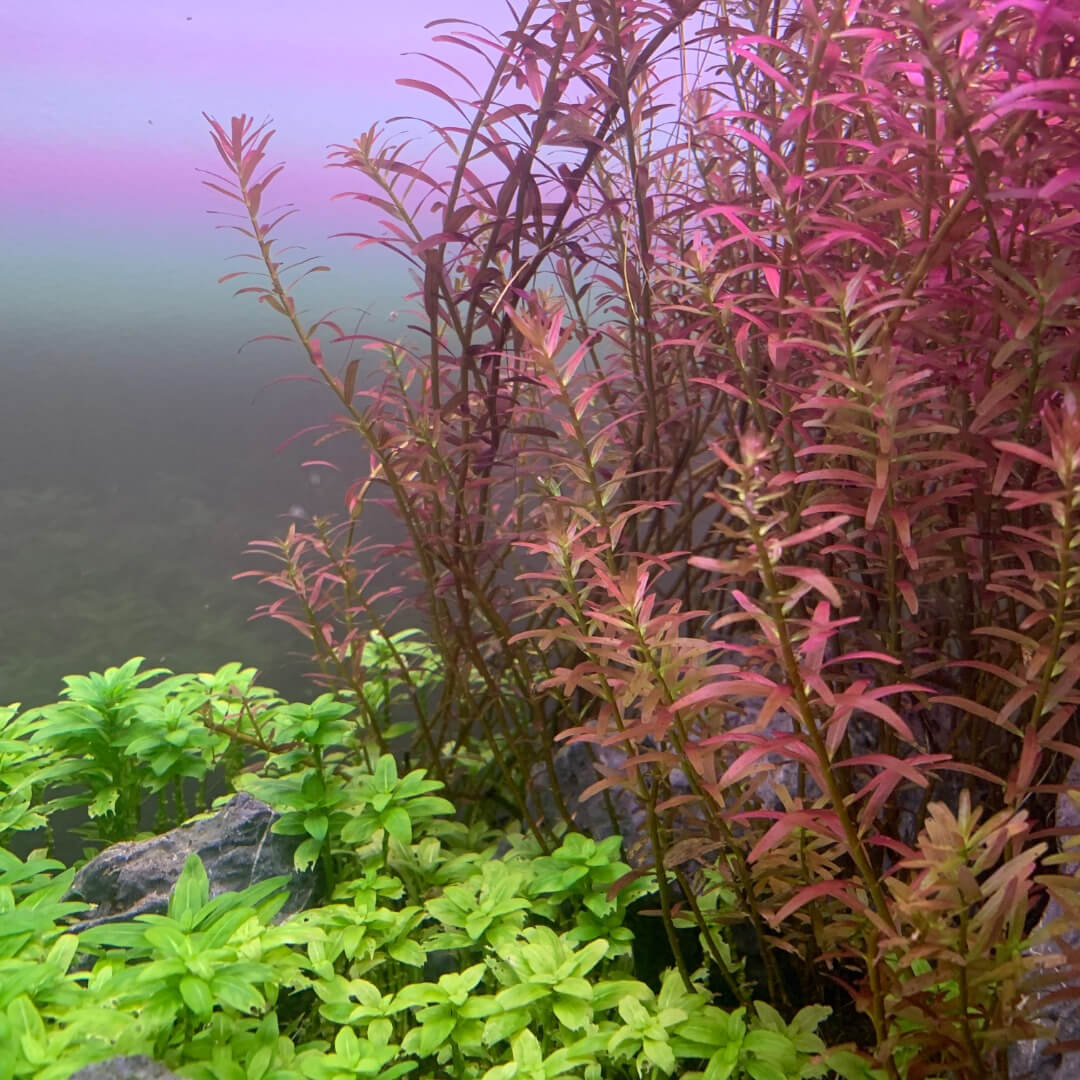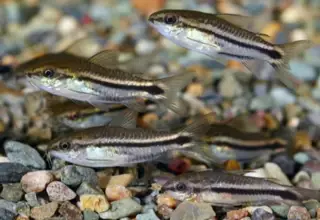Rotala H'ra: Care, Lighting Requirements, Appearance & More
Posted by on 3/28/2023
We use affiliate links and may receive a small commission on purchases.
Relatively new to the planted tank scene, Rotala H'ra, also known as Rotala Vietnam H'ra, is an attractive stem plant for hobbyists looking to add a pop of color to their freshwater aquarium. This plant showcases unique shades of green, pink, and red, but hobbyists will want to be well-versed in the plant's care before purchasing.
In this post, we'll discuss the appearance of the plant, growth rates, and lighting requirements. We'll also provide recommendations on placement and fertilization. Let's get started.
January's Giveaways on Light Fish
Species Summary
Some of the most popular stem plants in the planted tank hobby are members of the Rotala genus. Rotala Wallichii, Rotala Indica, and Rotala Rotundifolia have all found their way into award-winning tanks , but in recent years we've seen some new species make their way around the hobby. One of these plants is Rotala H'ra, also known as Rotala Gia Lai, and it hails from the tropical wetlands of Vietnam.
The plant has two distinct appearances, its emersed form showcases rounded leaves, while its submersed form features the pointed leaves seen in most Rotala species. This unique adaptation helps it grow in the tropical wetlands from which it originates.

Tank Benefits
Given the right conditions, Rotala H'ra is a fast-growing plant, which provides many benefits to a freshwater aquarium. Fast-growing plants will consume harmful organic compounds that are toxic to your inhabitants, and will ultimately purify the water column.
Rotala H'ra also provides an aesthetic benefit, resulting in a more visually appealing tank. Stem plants provide ample hiding spots for freshwater fish and invertebrates, especially for juveniles and fry, who are much more shy compared to their adult counterparts.
Appearance
Rotala H'ra has two distinct appearances based on whether the plant is grown emersed (growing above the surface of the water) and submerged (grown completely underwater.)
When grown emersed, Rotala H'ra will have small, rounded, green-colored leaves with a light-pink stem.
In an environment where Rotala H'ra is grown fully submerged, the plant will have pointed leaves that transition from light green to bright red as the plant creeps toward the water's surface. Lower leaves will remain a light-green color and gradually turn pink and eventually bright red. The red coloration of the leaves is the most vibrant when light intensity is strong, and available nitrate is lean (< 30 ppm).
Size & Growth Rate
Rotala H'Ra is similar in size to other Rotala plant species. The stem of the plant is only a few centimeters in width, emersed leaves will grow to be about ½ inch in length, while fully submerged leaves will grow to be about 1-1.5 inches.
Once established, Rotala H'Ra is a fast-growing plant, and under a high-light nutrient-rich environment, can easily grow 1-2 inches in height a week. Depending on the size of your tank, you'll likely need to frequently trim the plant.

Growth Rates will scale with light intensity. If you're looking to reduce the growth rate, simply reduce the light intensity. However, you should be aware that Rotala H'ra will be less-vibrant under low-intensity lighting.
Similar to other plants, the plant will stunt and show signs of deficiency if there aren't enough available nutrients in the water column. If the light intensity is high and CO2 is deficient, the plant will grow twisted, curled leaves.
🛒 Shop Freshwater Fish on Light Fish
Rotala H'ra Care
Caring for Rotala H'ra is relatively straightforward. Its care requirements are similar to other fast-growing Rotala species, such as Rotala Wallichii.
Due to the plant's lighting requirements, it may not be the best plant for beginners new to planted tanks. If you're considering this plant, you'll need to have a fertilization plan, reliable lighting, and a CO2 injection system in place.
Tank Size
We recommend having an aquarium that's at least 15 gallons in size for Rotala H'ra.
While technically any-sized tank will do, the plant's fast growth rate will require frequent trimmings, especially in a tank smaller than 15 gallons in size. Having a larger tank means less frequent trimmings, reducing the amount of maintenance required.
Water Parameters
Stable water parameters are essential for a planted tank, and you'll want to recreate the soft water environment of Rotala H'ra's natural habitat.
Rotala H'ra requires a steady stream of CO2 to be injected into the tank. While the plant won't die without CO2, it will be limited in its growth rate, and since it requires strong lighting, the absence of CO2 will result in an algae outbreak.
Aim for at least 30 ppm of CO2 when your lights come on. CO2 can be injected through a diffuser, and can be monitored with a drop checker.
Hobbyists will also need a reliable aquarium heater to re-create the plant's warm-watered native habitat.
Aim for the following water conditions:
Water temperature: 68-80°F
pH: 6-8
KH: 6-12 dkH
Substrate
Rotala H'ra will grow best in a nutrient-rich gravel-based substrate.
CaribSea's eco-complete is a great option, as well as Fluval Stratum or Bio-Stratum. For hobbyists who are interested in a red-colored substrate, Seachem's Flourite is also a good option. Even play sand can be used as long as you're aware of some of the pros and cons of a sand-based substrate.
Lighting
Rotala H'ra does best under high-light conditions (80-120 PAR). While technically it will stay alive under low-light conditions, the plant may stunt and show a much more dull coloration.
An 8-hour light cycle should be all that's needed to keep this attractive-looking stem plant.
Nutrient Dosing (Fertilization)
An ample amount of nutrients are a requirement for keeping Rotala H'ra, especially since it demands a high-light environment.
You can dose dry fertilizers directly into the tank, using a method such as Estimative Index , or you can dose liquid-based fertilizers, such as Flourish. Root Tabs can be used for additional nutrient supplementation.
The number of nutrients required will largely depend on the size of your tank, and the intensity of your lighting (as light is the primary driver of nutrient uptake.)
How to Plant It
Planting Rotala H'ra is as straightforward as it gets. Using a pair of aquarium tweezers , you can anchor the stem directly into the substrate. If the stem keeps uprooting, try planting the stem at an angle. After a few weeks, the plant should begin to grow roots and anchor itself into the substrate.
🛒 Shop Aquarium Plants Fish on Light Fish
Trimming & Pruning
Due to Rotala H'ra's fast growth, you'll need to trim the plant frequently. Using a pair of aquarium scissors , you can trim the plant directly along the stem.
The plant will grow two nodes at the point of cutting. We recommend allowing the plant to reach the water's surface, then trimming the plant 2-3 inches above the substrate. Allow the plant to grow once again to the plant's surface, and trim 2-3 inches above the last cutting. This will encourage lush growth, in a process known as hedging .
Tank Mates
Rotala H'ra is a suitable plant option for most peaceful schooling fish. We love the look of the plant with dark blue and purple colored fish, such as the Blue Emperor Tetra or Galaxy Koi Betta since their coloration contrasts nicely with the light-pink and red's seen in Rotala H'ra.
A few other tank mate options include Blue Dream Shrimp, Orange Pumpkin Shrimp, Bumblebee Platies, Pygmy Sunfish, and the Green Phantom Pleco.
Any fish on our list of Top 10 Centerpiece Fish for a 10-Gallon Tank will also work.
Just be sure to avoid cichlids, like the Cuban Cichlid, Electric Blue Jack Dempsey, or the Red Dragon Flowerhorn, as these fish will easily knock over and uproot delicate plants such as Rotala H'ra.
Propagation
Propagating Rotala H'ra is a breeze. Trim the plant along the stem and replant the cut portion, that's it! The plant will grow two nodes at the point of cutting, and the cut portion will continue to grow after a week or two.
Rotala H'ra will also produce side shoots once it reaches the surface. These side shoots will eventually reach the substrate, and grow into separate plants.
If you've recently introduced Rotala H'ra into your tank, allow it to transition to your tank's water parameters for a month or so before propagating. Once established, trimming a plant regularly is beneficial for your aquarium's ecosystem, but newly introduced plants may not be able to handle a sudden trimming.
Conclusion
Now that we've covered all of the important topics when it comes to Rotala H'ra care, do you think this stem plant might be a great addition to your planted aquarium? We expect Rotala H'ra to grow in popularity, so don't be surprised if you see this plant in some Instagram-worthy tanks soon.
Let us know what your thoughts are on the species in the comments below, and don't forget to check out our marketplace where you can buy and sell aquarium plants with other hobbyists.
January's Giveaways on Light Fish














